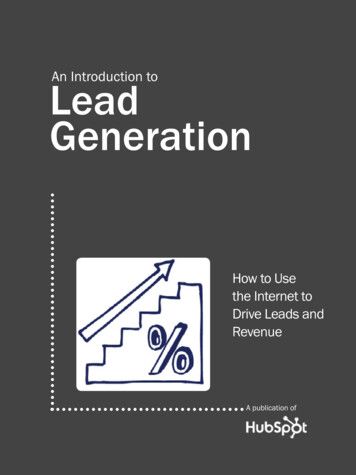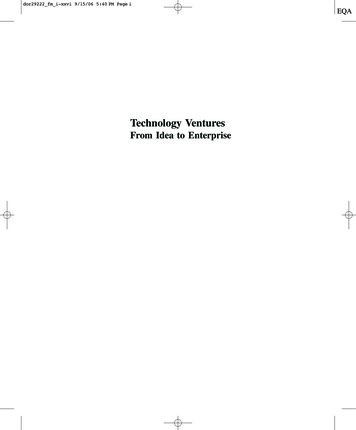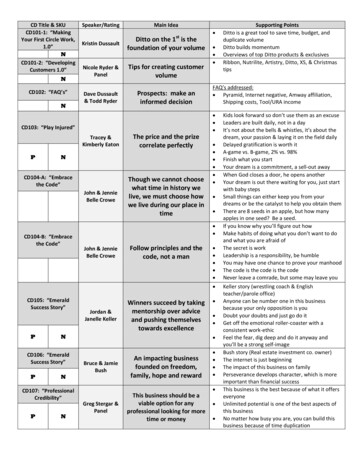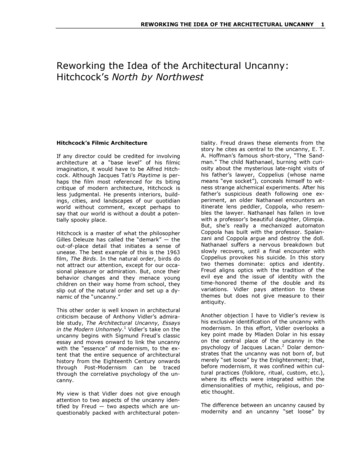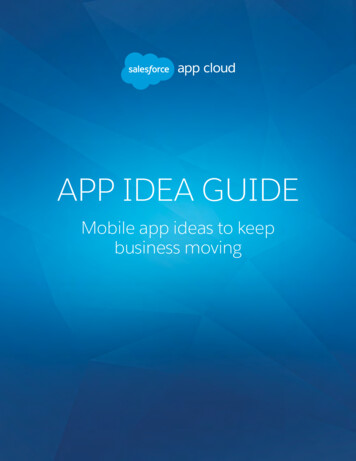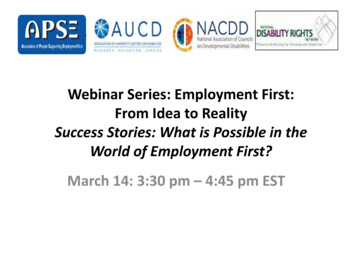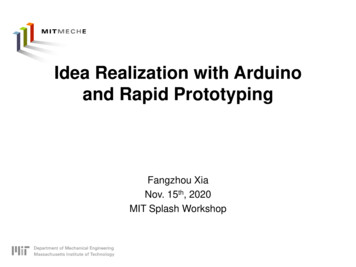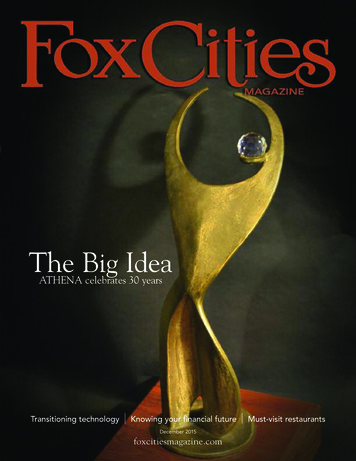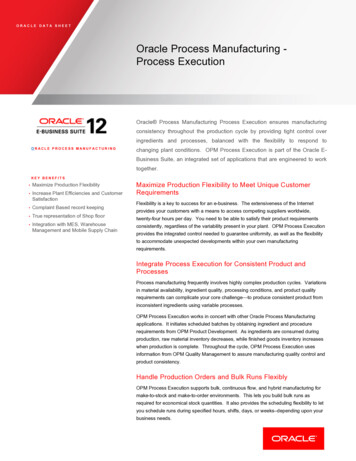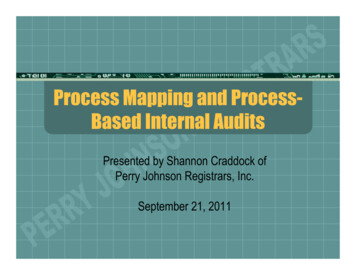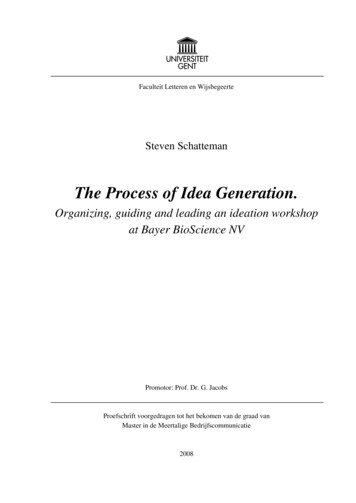
Transcription
Faculteit Letteren en WijsbegeerteSteven SchattemanThe Process of Idea Generation.Organizing, guiding and leading an ideation workshopat Bayer BioScience NVPromotor: Prof. Dr. G. JacobsProefschrift voorgedragen tot het bekomen van de graad vanMaster in de Meertalige Bedrijfscommunicatie2008
AcknowledgmentsFirst of all, I would like to thank everyone who contributed, directly or indirectly, to therealisation of this dissertation.Additionally, I would like to express my specific gratitude to Mr. André Roef and Mrs. IngridCazaerck, for their support and advice, over both the course of my internship and the developmentof this dissertation.iii
Table of contentsAcknowledgments . iiiTable of contents . ivIntroduction . 11. Company Presentation: Bayer BioScience NV . 31.1 History of Bayer BioScience NV . 31.1.1 1982 – 1996: Plant Genetic Systems . 31.1.2 1996 – 1999: Plant Genetics Systems becomes part of AgrEvo . 41.1.3 1999 – 2002: Aventis CropScience . 51.1.4 2002 – present: Bayer BioScience . 51.2 Company Structure . 61.2.1 Umbrella entity: Bayer AG . 61.2.1.1 Global Structure . 61.2.1.2 Bayer HealthCare . 91.2.1.3 Bayer MaterialScience . 91.2.1.4 Bayer CropScience . 101.2.1.5 Bayer Service Companies . 111.2.2 Local entity: Bayer BioScience N.V. . 121.2.2.1 Local Structure . 121.2.2.2 Supporting Services . 141.2.2.3 Host Organisations . 141.2.2.4 Communications department . 181.3 Corporate Identity: Bayer BioScience . 191.3.1 Mission statement . 191.3.2 Vision . 201.3.3 Strategy . 211.4 Bayer BioScience products . 221.4.1 Positioning of BioScience products . 221.4.2 Canola: InVigor . 221.4.3 Cotton: FiberMax . 231.4.4 Rice: Arize . 231.5 Competitors in the biotechnology market. 241.5.1 Market Overview and Positioning . 241.5.2 Syngenta. 261.5.3 Monsanto . 271.5.4 DuPont . 271.5.5 Dow AgroSciences . 27iv
1.6 SWOT-analysis . 292. The process of organisational idea generation . 302.1 Introduction . 302.2 Cognitive and social-psychological framework . 322.2.1 Introductory remarks. 322.2.2 Cognitive framework . 332.2.3 Social psychological framework . 362.3 The problem finding process . 372.3.1 Introductory remarks. 372.3.2 Individual or group ideation strategy . 372.3.2.1 Nominal versus interacting groups . 372.3.2.2 Disadvantages of group ideation . 392.3.2.3 Advantages of group ideation . 402.3.3 Group forming: illusion of productivity . 412.3.4 Setting goals for the ideation process . 432.4 The ideation process . 442.4.1 Introductory remarks. 442.4.2 Brainstorming as an ideation tool . 452.4.3 Facilitating a brainstorming session . 462.5 The selection and evaluation process . 482.5.1 Introductory remarks. 482.5.2 The concept of idea evaluation . 482.5.3 Strategies for idea evaluation . 502.6 Conclusion . 513. Case study: an internship at Bayer BioScience NV . 533.1 Introductory remarks . 533.2 Primary assignment: the ideation workshop . 543.2.1 Background and setting . 543.2.2 Preparatory phase . 553.2.2.1 Introductory remarks . 553.2.2.2 Getting acquainted with the subject . 553.2.2.3 Logistic and practical preparations . 573.2.2.4 Construction of the workshop agenda . 603.2.3 Ideation workshop at Bayer Antwerpen . 613.2.3.1 Introductory remarks . 613.2.3.2 Introduction and first acquaintance . 613.2.3.3 Animal Health presentation . 623.2.3.4 Top of mind exercise. 623.2.3.5 I like/don‟t like exercise . 623.2.3.6 Accidental discovery exercise . 633.2.3.7 Well-being exercise. 633.2.3.8 Ranking and evaluation of ideas . 63v
3.2.4 Workshop roll-out . 643.2.5 Assignment evaluation . 643.3 Secondary assignments . 663.3.1 Introductory remarks. 663.3.2 Translations . 663.3.3 Editorial contributions . 66Conclusion . 68Bibliography. 70Appendix . 75vi
IntroductionInnovation and creativity are imperative in the contemporary organisational environment. In orderto remain competitive, companies continually have to improve their existing products andservices, and develop new products and services. In this respect, creativity of a company‟semployees is of paramount importance for the effectiveness of an organisation, as market researchand analysis are expensive and time-consuming methods to ensure innovation. Therefore, manycompanies decide to invest in internal idea generation, where the company‟s work force ismotivated and stimulated to generate new ideas. Investing in specific idea generation for aparticular subject with clear objectives can result in both short-term (the immediately generatedideas for potential new products) and long-term (a changed employee attitude towards creativity)benefits. A number of techniques and strategies for organisational idea generation have beendeveloped to support idea generation in organisations. Organizing brainstorming sessions hasemerged as the most frequently used of these different methods. I will analyse the concept oforganisational idea generation via brainstorming sessions, illustrating this concept with a specificcase study, viz. the organisation, guidance and lead of an ideation session at Bayer BioScienceNV.In the first chapter of this dissertation, I will discuss and analyse the company of myinternship, focusing on the company history and structure (both on global and local level), itscorporate identity (mission statement, values and strategy), products and position in thecompetitive environment. The chapter will be concluded in a summarizing SWOT-analysis,reiterating the company‟s strengths, weaknesses, opportunities and threats.The second chapter focuses on the theoretical background and framework of organisationalcreativity, and, more specifically, the concept of idea generation. In this chapter, I will start from acognitive and social-psychological approach to idea generation, and subsequently move to a morepractically oriented approach of the three different stages of ideation (problem finding, ideationand evaluation), discussing key elements of these three stages in the idea generation process.The description of my internship is the central element in the third chapter. In this case study, Iwill elaborate on the different aspects of the ideation workshop that I conducted at BayerBioScience NV, paying specific attention to the three key internship phases: preparation, ideationworkshop and workshop roll-out. The description of the ideation workshop in all its aspects willbe followed by an evaluation of the assignment and my input in this project. Additionally, I will1
discuss the secondary tasks I performed during my internship, ranging from translations toeditorial con
competitive environment. The chapter will be concluded in a summarizing SWOT-analysis, reiterating the company‟s strengths, weaknesses, opportunities and threats. The second chapter focuses on the theoretical background and framework of organisational creativity, and, more specifically, the concept of idea generation. In this chapter, I will .
